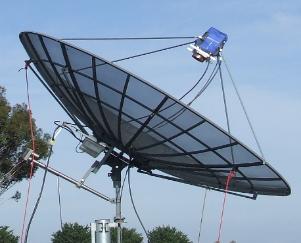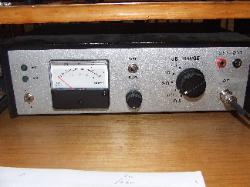| VK3NX Australian Amateur Radio Station Dish and Control Page |


| Dish Mechanics The 3.7m Joysat mesh dish is mounted on a SOLID 50mm diam mast that is attached to a 2.5m long 100mm diameter pole. The pole is 1.8m into the ground and set in concrete. It will easily handle a small tower with a more sizeable dish...perhaps in the future. Steering is via actuator control. The Azimuth is controlled by a 36" actuator and Elevation via a 24" actuator. To cover the Azimuth movement of the moon, 2 positions of the jackscrew are utilised, 90 degrees apart. I position for E-N travel and the other for N-W. The Elevation travel was set up for > 90 degrees so the dish could be pointed -5 degrees below the horizon for Gnd Noise / CS measurements. The Jackscrews have a Mechanical REED switch built in. The switch closes 32 times per 1" of travel. This is used to provide positioning information utilising the VK5DJ BEAM INDICATOR (using the "Jackscrew solution"). |
| A wideband noise amplifier and detector is used to measure sun / moon noise and for tracking via moon noise. The Noise amplifier operates with a bandwidth of 4 MHz and at 141 MHz. FSD is selected as "full", "10", "2", "1", or "0.5"db" It has a "Zero" offset adjustment and gives excellent accuracy when doing CS/GND , sun and moon noise measurements. On the higher uW bands I found it invaluable as a tracking tool to measure moon noise and keep the dish "peaked" on the moon. The Noise Meter uses an AD8307 log detector device and is preceeded by ~ 40dB of gain with helical filtering employed, centred on 141 MHz. (I use a 144MHz IF for all my uW EME transverters.) Noise Meter Schematics |
A Rx splitter is used in the IF path to supply a signal to the Noise meter
.It provides ~10dB Gain
.It provides ~10dB Gain
A "CAGE" setup is used at the focal point to allow easy feed changes. All the feeds are fabricated so they can slide
in and out and bolt into place with 4 "wing nuts". It takes about 10 min to lower the dish and change feeds! The Tx,
Rx and DC changeover lines are brought to each feed and are made interchangeable/ universal between the feeds.
Each "Feed" contains the feedhorn, preamp, LNA isolating relays and 12- 28 V converters for the relays. All power
amplifiers are housed under the dish in the "moon buggy" and 5m of LMR 600 (useable to 10 GHz!) transfers power
to the "feed box". The transverters are located in the "tin shed" when in use and LMR400 is used to the Feed box to
connect to the LNA's. Because No PAs are located at the feed the feed assemblies are all quite light in terms of
weight and of "small" size.


| External and internal views of "Wideband noise amplifier and detector unit" |


| "Older" 5.7 Ghz and 10 GHz feeds on the bench. |
| Wideband Noise detector Meter: |
DISH CONTROL I built the VK5DJ controller and found that the accuracy is excellent!........... Provided the calibration process is completed with great care. Recently I rebuilt my control unit. I combined my VK5DJ based control board with my Elevation and Azimuth motor control units. I noticed that John VK5DJ has done a lot of work on his program since I first built mine. It supports MANY options and I suggest looking closely at it's functions for anyone considering how they will control / manage the aiming and tracking aspects of an EME Dish. The new on screen doppler calculation is one of many improvements. Refer to John Drew's website for complete details. (board kits are available) |








